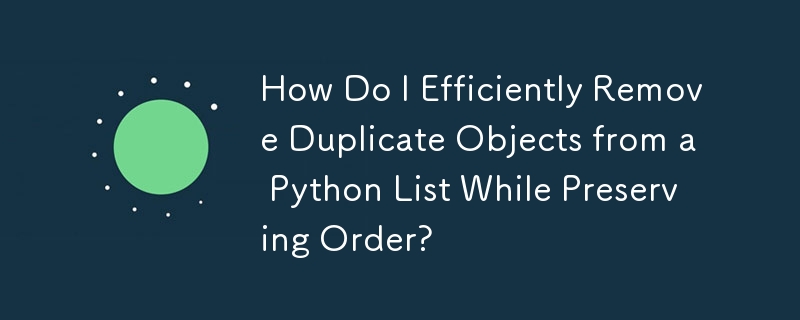如何在保留顺序的同时有效地从 Python 列表中删除重复的对象?
发布于2024-11-03

使用 Python 高效处理重复对象
在 Python 中,可能需要从列表中删除重复对象,同时保持原始顺序。当您有自定义对象列表并希望根据某些条件过滤重复项或检查数据库中的重复项时,就会出现此问题。
根据您的具体要求,您需要定义对象内的唯一性才能有效使用set(list_of_objects) 方法。这涉及通过实现 eq 和 hash 方法使对象可哈希。
eq 方法定义对象相等性。例如,如果您的 Book 对象具有author_name 和 title 属性,其中作者和标题的组合是唯一的,则 eq 方法可能如下所示:
def __eq__(self, other):
return self.author_name == other.author_name and self.title == other.title同样,hash方法生成对象的哈希值。一种常见的方法是对关键属性的元组进行哈希处理:
def __hash__(self):
return hash(('title', self.title, 'author_name', self.author_name))有了这些方法,您现在可以从 Book 对象列表中删除重复项:
books = [Book('title1', 'author1'), Book('title2', 'author2'), Book('title1', 'author1')]
unique_books = list(set(books))此外,要检查数据库中的重复项,可以使用以下方法:
import sqlalchemy
session = sqlalchemy.orm.sessionmaker()()
records = session.query(YourModel).all()
existing_titles = set([record.title for record in records])
unique_objects = [obj for obj in objects if obj.title not in existing_titles]
最新教程
更多>
-
 在黑客马拉松中使用 Kintone 的技巧Introduction When you're participating in a hackathon, efficiency and quick iteration are key to success. One tool that can help you manage d...编程 发布于2024-11-08
在黑客马拉松中使用 Kintone 的技巧Introduction When you're participating in a hackathon, efficiency and quick iteration are key to success. One tool that can help you manage d...编程 发布于2024-11-08 -
 Camp Code - 一种有趣且简单的学习代码的方法??未来的编程传奇,齐聚一堂!营地代码着火了! ?? 短短 3 天(对于编码爱好者来说这是 72 小时?): • 超过 1,300 名冒险家加入了我们的编码任务? • 超过 300 名勇敢的探索者创建了早期访问帐户来测试我们的测试版?️ 为什么这么热闹? ? 因为 Camp Code 不仅仅是学习编...编程 发布于2024-11-08
Camp Code - 一种有趣且简单的学习代码的方法??未来的编程传奇,齐聚一堂!营地代码着火了! ?? 短短 3 天(对于编码爱好者来说这是 72 小时?): • 超过 1,300 名冒险家加入了我们的编码任务? • 超过 300 名勇敢的探索者创建了早期访问帐户来测试我们的测试版?️ 为什么这么热闹? ? 因为 Camp Code 不仅仅是学习编...编程 发布于2024-11-08 -
 随时随地的包管理器(几天后可用。)https://github.com/DiegoDev2/Fleet 介绍 Fleet:面向开发人员的简单但功能强大的包管理器? 作为开发人员,我们经常花费大量时间设置环境并安装不同的工具。我创建了 Fleet 来使这个过程更容易、更高效。 什么是舰队? Fleet ...编程 发布于2024-11-08
随时随地的包管理器(几天后可用。)https://github.com/DiegoDev2/Fleet 介绍 Fleet:面向开发人员的简单但功能强大的包管理器? 作为开发人员,我们经常花费大量时间设置环境并安装不同的工具。我创建了 Fleet 来使这个过程更容易、更高效。 什么是舰队? Fleet ...编程 发布于2024-11-08 -
 项目 检查参数有效性章节:方法设计 重点:方法设计的可用性、稳健性和灵活性。 覆盖范围:参数和返回值处理、方法签名设计和文档。 第 49 项:检查参数有效性 - 参数限制: 方法和构造函数通常对参数值有限制(例如非负索引、非空引用)。 这些限制必须在方法开始时记录和验证。 - 验证的重要性: 尽早检测错误,以避免方法中...编程 发布于2024-11-08
项目 检查参数有效性章节:方法设计 重点:方法设计的可用性、稳健性和灵活性。 覆盖范围:参数和返回值处理、方法签名设计和文档。 第 49 项:检查参数有效性 - 参数限制: 方法和构造函数通常对参数值有限制(例如非负索引、非空引用)。 这些限制必须在方法开始时记录和验证。 - 验证的重要性: 尽早检测错误,以避免方法中...编程 发布于2024-11-08 -
 如何在不删除和重新创建约束的情况下重命名 MySQL 中的外键列?重命名 MySQL 中的外键列:分步指南当尝试重命名 MySQL 中充当外键列的列时外键在另一个表中时,经常会遇到错误150,表明外键约束问题。为了克服这个问题,您可能会遇到这样的问题:我们能否避免删除外键、重命名列,然后重新创建外键的复杂任务?标准方法根据MySQL文档和提供的答案,最安全、最直接...编程 发布于2024-11-08
如何在不删除和重新创建约束的情况下重命名 MySQL 中的外键列?重命名 MySQL 中的外键列:分步指南当尝试重命名 MySQL 中充当外键列的列时外键在另一个表中时,经常会遇到错误150,表明外键约束问题。为了克服这个问题,您可能会遇到这样的问题:我们能否避免删除外键、重命名列,然后重新创建外键的复杂任务?标准方法根据MySQL文档和提供的答案,最安全、最直接...编程 发布于2024-11-08 -
 Go 中如何表示接口:(值、类型)对或方法表?理解 Go 中的接口表示在 Go 中使用接口时,掌握其底层表示非常重要。两个关键资源阐明了这个主题,但他们的观点不同。“反射定律”文章 (http://blog.golang.org/laws-of-reflection) 介绍了接口的概念包含一个(值,类型)对,如 r io.Reader 的示例所...编程 发布于2024-11-08
Go 中如何表示接口:(值、类型)对或方法表?理解 Go 中的接口表示在 Go 中使用接口时,掌握其底层表示非常重要。两个关键资源阐明了这个主题,但他们的观点不同。“反射定律”文章 (http://blog.golang.org/laws-of-reflection) 介绍了接口的概念包含一个(值,类型)对,如 r io.Reader 的示例所...编程 发布于2024-11-08 -
![如何在 Go 中将映射编组为 XML:当出现“xml:不支持的类型:map[string]int”错误时该怎么办?](/style/images/moren/moren.png) 如何在 Go 中将映射编组为 XML:当出现“xml:不支持的类型:map[string]int”错误时该怎么办?Go 中将映射编组为 XML尝试将映射转换为 XML 数据时,开发人员可能会遇到错误,指出“xml: 不支持的类型:map[string] int。”尽管 JSON 可以使用编组映射,但默认情况下 XML 不支持编组映射。此问题的一个解决方案是利用 xml.Marshaler 接口。通过创建自定义 ...编程 发布于2024-11-08
如何在 Go 中将映射编组为 XML:当出现“xml:不支持的类型:map[string]int”错误时该怎么办?Go 中将映射编组为 XML尝试将映射转换为 XML 数据时,开发人员可能会遇到错误,指出“xml: 不支持的类型:map[string] int。”尽管 JSON 可以使用编组映射,但默认情况下 XML 不支持编组映射。此问题的一个解决方案是利用 xml.Marshaler 接口。通过创建自定义 ...编程 发布于2024-11-08 -
 如何使用简单的 HTML DOM 从 HTML 内容中删除图像元素?使用简单 HTML DOM 删除元素您有一个任务,需要使用简单 HTML DOM 从文章中删除所有图像元素。目标是为新闻滚动条显示创建简洁的文本片段。要实现此目的,您可以按照以下步骤操作:1.获取 HTML 字符串内容获取 HTML 格式字符串形式的文章内容。2.删除图像标签简单的 HTML DOM...编程 发布于2024-11-08
如何使用简单的 HTML DOM 从 HTML 内容中删除图像元素?使用简单 HTML DOM 删除元素您有一个任务,需要使用简单 HTML DOM 从文章中删除所有图像元素。目标是为新闻滚动条显示创建简洁的文本片段。要实现此目的,您可以按照以下步骤操作:1.获取 HTML 字符串内容获取 HTML 格式字符串形式的文章内容。2.删除图像标签简单的 HTML DOM...编程 发布于2024-11-08 -
 为什么 requestAnimationFrame 对于动画优于 setInterval 和 setTimeout?为什么 requestAnimationFrame 比 setInterval 或 setTimeout 更好虽然 setInterval 和 setTimeout 都可以用于动画任务,但出于多种原因,requestAnimationFrame 通常被认为是更好的选择。1。与显示刷新率同步reque...编程 发布于2024-11-08
为什么 requestAnimationFrame 对于动画优于 setInterval 和 setTimeout?为什么 requestAnimationFrame 比 setInterval 或 setTimeout 更好虽然 setInterval 和 setTimeout 都可以用于动画任务,但出于多种原因,requestAnimationFrame 通常被认为是更好的选择。1。与显示刷新率同步reque...编程 发布于2024-11-08 -
 React Hooks 示例Introduction: Embracing the Power of React Hooks Hey there, fellow UI developer! Are you ready to dive into the exciting world of React Hooks...编程 发布于2024-11-08
React Hooks 示例Introduction: Embracing the Power of React Hooks Hey there, fellow UI developer! Are you ready to dive into the exciting world of React Hooks...编程 发布于2024-11-08 -
 如何在 PDO 中有效地使用带有 LIMIT 子句的数组参数利用 PDO 数组参数和 LIMIT 子句在 PHP 中,使用 PDO 执行带有参数数组和 LIMIT 子句的数据库查询可能会带来挑战。让我们探讨一下如何有效地解决这种情况。背景:在利用数组将参数传递给 PDO 语句时尝试使用 LIMIT 子句执行查询时会出现此问题。默认情况下,LIMIT子句中的:...编程 发布于2024-11-08
如何在 PDO 中有效地使用带有 LIMIT 子句的数组参数利用 PDO 数组参数和 LIMIT 子句在 PHP 中,使用 PDO 执行带有参数数组和 LIMIT 子句的数据库查询可能会带来挑战。让我们探讨一下如何有效地解决这种情况。背景:在利用数组将参数传递给 PDO 语句时尝试使用 LIMIT 子句执行查询时会出现此问题。默认情况下,LIMIT子句中的:...编程 发布于2024-11-08 -
 如何在 C++ 中为交互式应用程序实现非阻塞控制台输入?C 中的非阻塞控制台输入 在现代 C 中,非阻塞控制台输入允许在程序运行时无缝处理用户命令继续运行并输出信息。此功能在交互式应用程序和游戏中通常至关重要。C 11 解决方案:实现非阻塞控制台输入的一种有效方法是使用单独的控制台线。这种方法允许主程序继续执行,同时后台线程监视控制台的输入。以下代码示例...编程 发布于2024-11-08
如何在 C++ 中为交互式应用程序实现非阻塞控制台输入?C 中的非阻塞控制台输入 在现代 C 中,非阻塞控制台输入允许在程序运行时无缝处理用户命令继续运行并输出信息。此功能在交互式应用程序和游戏中通常至关重要。C 11 解决方案:实现非阻塞控制台输入的一种有效方法是使用单独的控制台线。这种方法允许主程序继续执行,同时后台线程监视控制台的输入。以下代码示例...编程 发布于2024-11-08 -
 哪些 JSF 2.0 框架最适合构建 CRUD 应用程序?推荐的 JSF 2.0 CRUD 框架在 JSF 2.0 中,由于内置功能,开发 CRUD 应用程序变得轻而易举。使用 @ViewScoped bean 和 的组合提供了坚实的基础。轻量级实现对于具有最小依赖性的轻量级方法,以下代码片段演示了如何实现CRUD操作:// Bean: @Managed...编程 发布于2024-11-08
哪些 JSF 2.0 框架最适合构建 CRUD 应用程序?推荐的 JSF 2.0 CRUD 框架在 JSF 2.0 中,由于内置功能,开发 CRUD 应用程序变得轻而易举。使用 @ViewScoped bean 和 的组合提供了坚实的基础。轻量级实现对于具有最小依赖性的轻量级方法,以下代码片段演示了如何实现CRUD操作:// Bean: @Managed...编程 发布于2024-11-08
学习中文
- 1 走路用中文怎么说?走路中文发音,走路中文学习
- 2 坐飞机用中文怎么说?坐飞机中文发音,坐飞机中文学习
- 3 坐火车用中文怎么说?坐火车中文发音,坐火车中文学习
- 4 坐车用中文怎么说?坐车中文发音,坐车中文学习
- 5 开车用中文怎么说?开车中文发音,开车中文学习
- 6 游泳用中文怎么说?游泳中文发音,游泳中文学习
- 7 骑自行车用中文怎么说?骑自行车中文发音,骑自行车中文学习
- 8 你好用中文怎么说?你好中文发音,你好中文学习
- 9 谢谢用中文怎么说?谢谢中文发音,谢谢中文学习
- 10 How to say goodbye in Chinese? 再见Chinese pronunciation, 再见Chinese learning








![如何在 Go 中将映射编组为 XML:当出现“xml:不支持的类型:map[string]int”错误时该怎么办?](http://www.luping.net/uploads/20241029/17301600156720258f119a2.jpg)
















